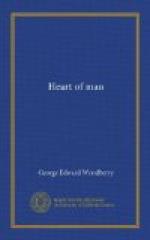These several sorts of types make an ascending series from the predominantly physical to the predominantly spiritual; but, from the present point of view, the arts which embody their creations in a material form should not be opposed to literature which employs the least interrelation of sensation, as if the former had a physical and the last a spiritual content. All types have one common element, they express personality; they have for the mind a spiritual meaning, what they contain of human character; they differ here only in fulness of representation. The most purely physical types imply spiritual qualities, choice, will, command,—all the life which was a condition precedent to the bodily perfection that was its flower; and, though the eye rests on the beautiful form, it may discern through it the human soul of the athlete as in life; and, moreover, the figure may be represented in some significant act, or mood even, but this last is rare. The more plainly spiritual types, physically rendered, are most often shown in some such mood or act expressive in itself of the soul whose habit lives in the form it has moulded. It is not that the plastic and pictorial arts cannot spiritualize the stone and the canvas as well as humanize it bodily; equally with the poetic art they reveal character, but within narrower bounds. The limitation of these arts in embodying personality is one of scope, not of intention; and though it springs out of their use of material forms, it does so in a peculiar way. It is not the employment of a physical medium of communication that differentiates them, for a physical medium of some sort is the only means of exchange between mind and mind; neither is it the employment of a physical basis, for all art, being concrete, rests on a physical basis—the world of imagination is exhaled from things that are. The physical basis of a drama, for instance, is manifest when it is enacted on the stage; but it is substantially the same whether beheld in thought or ocularly.




